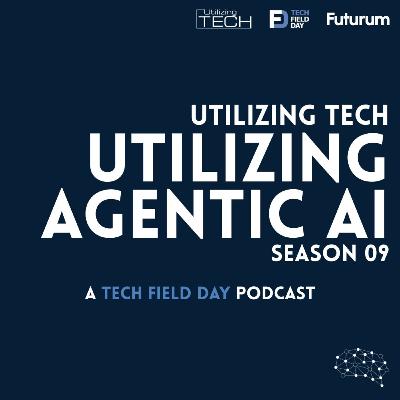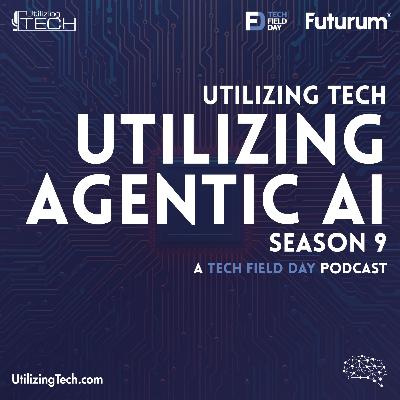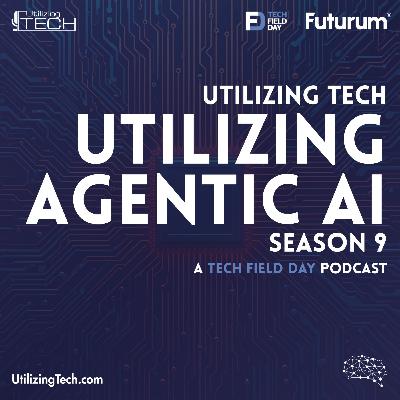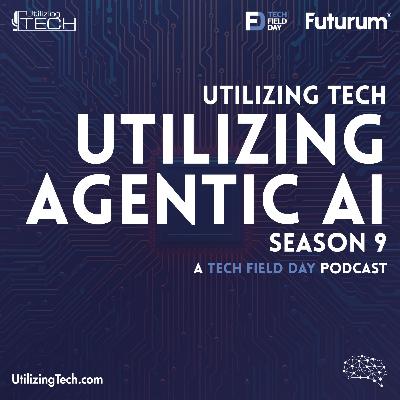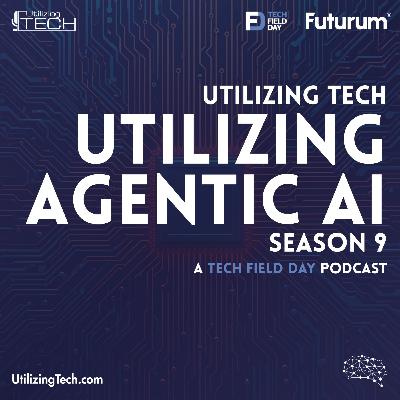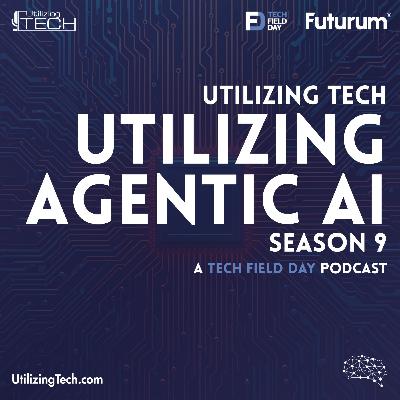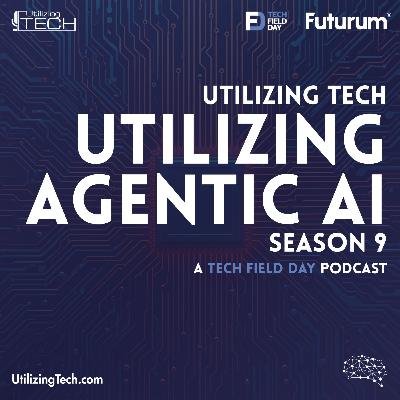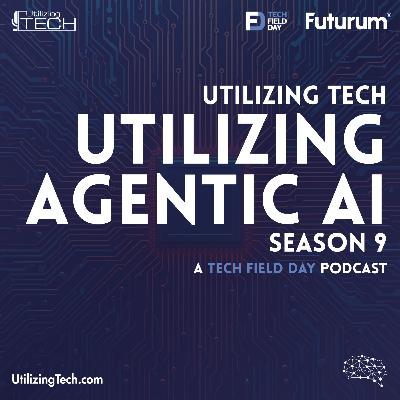Discover Utilizing Tech - The Podcast Series about New and Emerging Technologies
Utilizing Tech - The Podcast Series about New and Emerging Technologies

Utilizing Tech - The Podcast Series about New and Emerging Technologies
Author: Tech Field Day - Part of The Futurum Group
Subscribed: 25Played: 330Subscribe
Share
© Tech Field Day - Part of The Futurum Group
Description
Utilizing Tech is a weekly podcast exploring practical technology in the modern enterprise. Each season spotlights an emerging area: three seasons on AI, plus dedicated seasons on CXL and Edge. Season Six revisited AI, while Seasons Seven and Eight—presented by Solidigm—examined AI Data Infrastructure and AI at the Edge. Now, Season Nine turns to Agentic AI.
166 Episodes
Reverse
Agentic AI is an autonomous system that learns, adapts, and uses tools on the behalf of its users. This final episode of Season 9 of Utilizing Tech brings hosts Stephen Foskett, Frederic Van Haren, and Guy Currier together to reflect on the lessons we've learned over the last few months. AI keeps advancing incredibly rapidly, and we timed this season with the emergence of practical agentic AI platforms, AI Field Day 7, and a report on enterprise AI from The Futurum Group. During the conversation, the panel references Kamiwaza, Articul8, ApertureData, NetApp, Perplexity, OpenAI, and more. Agents have to be personal, focused yet flexible, and capable of integrating with each other, data, and tools. We also discussed the need for platforms, with companies like OpenAI and Microsoft positioning themselves to be the platform for AI applications even as enterprise software companies like ServiceNow and Salesforce are trying to do the same. We also have many companies developing platforms for orchestration and operation of AI, and data platforms designed to support agents. Ultimately, agentic AI will be a core capability of next-generation applications, with autonomous agents interacting with tools and helping us perform daily tasks.Hosts: Stephen Foskett, President of the Tech Field Day Business Unit and Organizer of the Tech Field Day Event SeriesFrederic Van Haren, Founder and CTO of HighFens, Inc. Guy Currier, Chief Analyst at Visible Impact, The Futurum Group.For more episodes of Utilizing Tech, head to the dedicated website and follow the show on X/Twitter, on Bluesky, and on Mastodon.
As customers try to figure out how to present data to Agentic AI applications, many of them are realizing that it’s time for the storage infrastructure team to step up and take a seat at the table. In this episode of Utilizing Tech, recorded live at NetApp Insight in Las Vegas, hosts Stephen Foskett and Guy Currier from The Futurum Group sit down with Ingo Fuchs, Chief Technologist for AI at NetApp, to explore the critical role of data infrastructure in supporting enterprise AI and agentic AI applications. As organizations move AI workloads into production, traditional infrastructures—especially storage teams—must take a more active role in enabling performance, efficiency, and governance. Ingo emphasizes the emerging needs for data quality, control, compliance, and currency, particularly as AI agents begin making decisions and interacting with sensitive enterprise data. The conversation highlights how NetApp’s capabilities, such as AI Data Engine and native infrastructure integrations, enable real-time data pipeline management, enforce guardrails, and ensure consistent and secure data delivery. This shift represents a transformative intersection of storage, infrastructure, and AI operations, paving the way for scalable and reliable enterprise AI solutions.Guest: Nick Patience, VP and Practice Lead for AI at The Futurum GroupHosts: Stephen Foskett, President of the Tech Field Day Business Unit and Organizer of the Tech Field Day Event SeriesFrederic Van Haren, Founder and CTO of HighFens, Inc. Guy Currier, Chief Analyst at Visible Impact, The Futurum Group.For more episodes of Utilizing Tech, head to the dedicated website and follow the show on X/Twitter, on Bluesky, and on Mastodon.
Although there's a lot of skepticism around generative AI, companies are finding incredible practical uses for these new capabilities. This episode of Utilizing Tech brings Luke Norris of Kamiwaza to discuss business outcomes that can be achieved by AI applications with hosts Guy Currier and Stephen Foskett. Agentic AI is an autonomous system that has a schedule, and action, or an interface to interact with it. Apps should represent the data rather than vice versa, so a dashboard should reconfigure and recompute to serve the needs of a user. Kamiwaza recently announced a capability to make applications accessible to people with disabilities, and this represents the kind of real-world benefit that can be delivered by AI. They previously worked with NOAA to make historic data more accessible to modern users.Luke Norris, CEO and Founder of Kamiwaza AIHosts: Stephen Foskett, President of the Tech Field Day Business Unit and Organizer of the Tech Field Day Event SeriesFrederic Van Haren, Founder and CTO of HighFens, Inc. Guy Currier, Chief Analyst at Visible Impact, The Futurum Group.For more episodes of Utilizing Tech, head to the dedicated website and follow the show on X/Twitter, on Bluesky, and on Mastodon.
We are surrounded by intelligent devices and these increasingly use various AI interfaces and processing capabilities to support the needs of users. This episode of Utilizing Tech focuses on edge AI and AI assistants and agents with Olivier Blanchard of The Futurum Group along with Frederic Van Haren and Stephen Foskett. We have all used so-called intelligent assistants, starting with Apple Siri and Amazon Alexa and continuing with Google, Microsoft, and many others. These voice interfaces are increasingly functioning as agents, connecting with various data sources and tools to perform tasks on the behalf of the user. AI assistants have arrived at the same overall paradigm as AI agents, and there is an inevitable crossover between these technologies, as the best of breed components are adopted. The needs of AI assistants has also lead to an increase in availability of specialized processing on PCs and even personal devices, and this helps offload the tremendous need for power and space of AI applications.Guest: Olivier Blanchard, Research Director at The Futurum GroupHosts: Stephen Foskett, President of the Tech Field Day Business Unit and Organizer of the Tech Field Day Event SeriesFrederic Van Haren, Founder and CTO of HighFens, Inc. Guy Currier, Chief Analyst at Visible Impact, The Futurum Group.For more episodes of Utilizing Tech, head to the dedicated website and follow the show on X/Twitter, on Bluesky, and on Mastodon.
As customers try to figure out how to present data to Agentic AI applications, many of them are realizing that it’s time for the storage infrastructure team to step up and take a seat at the table. In this episode of Utilizing Tech, recorded live at NetApp Insight in Las Vegas, hosts Stephen Foskett and Guy Currier from The Futurum Group sit down with Ingo Fuchs, Chief Technologist for AI at NetApp, to explore the critical role of data infrastructure in supporting enterprise AI and agentic AI applications. As organizations move AI workloads into production, traditional infrastructures—especially storage teams—must take a more active role in enabling performance, efficiency, and governance. Ingo emphasizes the emerging needs for data quality, control, compliance, and currency, particularly as AI agents begin making decisions and interacting with sensitive enterprise data. The conversation highlights how NetApp’s capabilities, such as AI Data Engine and native infrastructure integrations, enable real-time data pipeline management, enforce guardrails, and ensure consistent and secure data delivery. This shift represents a transformative intersection of storage, infrastructure, and AI operations, paving the way for scalable and reliable enterprise AI solutions.'Guest: Ingo Fuchs, Chief Technologist of AI at NetAppHosts: Stephen Foskett, President of the Tech Field Day Business Unit and Organizer of the Tech Field Day Event SeriesFrederic Van Haren, Founder and CTO of HighFens, Inc. Guy Currier, Chief Analyst at Visible Impact, The Futurum Group.For more episodes of Utilizing Tech, head to the dedicated website and follow the show on X/Twitter, on Bluesky, and on Mastodon.
Most generative AI work has been fairly general purpose to date, but it is far more effective to develop expert models focused on specific industries. This episode of Utilizing Tech features Arun Subramaniyan, founder and CEO of Articul8 AI, in conversation with Guy Currier and Stephen Foskett. According to Arun, an agent is a model with a set of tools plus data that has agency to be called and interact with other agents. If these agents are domain-specific they can perform tasks more effectively than general purpose agents at certain points in this chain. Agentic AI is able to accomplish tasks previously thought impossible, and these systems keep improving. But people remain responsible for using and managing these systems. Costs can rise significantly if AI is used improper, but it is possible to deploy it profitably. Companies that can combine domain expertise with a novel AI-powered application are breaking free from the pack.Guest: Arun Subramaniyan, CEO and Founder of Articul8 AIHosts: Stephen Foskett, President of the Tech Field Day Business Unit and Organizer of the Tech Field Day Event SeriesFrederic Van Haren, Founder and CTO of HighFens, Inc. Guy Currier, Chief Analyst at Visible Impact, The Futurum Group.For more episodes of Utilizing Tech, head to the dedicated website and follow the show on X/Twitter, on Bluesky, and on Mastodon.
From the very first episode of this podcast back in 2020, we've been focused on practical applications for AI technology, and we're starting to see these come to market with agentic tools. This episode of Utilizing Tech features Brad Shimmin, VP and Practice Lead for Data and Analytics at The Futurum Group discussing the ways AI is gaining autonomy with hosts Frederic Van Haren of HighFens and Stephen Foskett, organizer of AI Field Day. Agentic AI is all about autonomy, leveraging generative AI to perform actions on our behalf. There are many different types of agentic AI components, ranging from tools for data and analytics, connections and processes for integrating data, and end-user agents. Increasingly, model context protocol (MCP) is used to specify the capabilities and data for each of these tools, enabling them to work together as part of an agentic process. Frameworks like agent2agent (A2A) enable these components to work together. And models are becoming true platforms to serve the needs of users. Companies like OpenAI, Google, Anthropic, and Mistral are transforming their models into real agentic platforms, while Salesforce, Microsoft, Oracle, Google, and more are trying to support their business customers with Agentic AI. The Futurum Group is addressing this market with their new Signal reports, including a forthcoming one focused on agentic AI.Guest: Brad Shimmin, VP and Practice Lead, Data and Analytics at The Futurum GroupHosts: Stephen Foskett, President of the Tech Field Day Business Unit and Organizer of the Tech Field Day Event SeriesFrederic Van Haren, Founder and CTO of HighFens, Inc. Guy Currier, Chief Analyst at Visible Impact, The Futurum Group.For more episodes of Utilizing Tech, head to the dedicated website and follow the show on X/Twitter, on Bluesky, and on Mastodon.
Our online interactions include audio, video, and sensor data, but most AI applications are still focused on text. This episode of Utilizing Tech considers how we can integrate multimodal data with agentic applications with Vishakha Gupta, founder and CEO of ApertureData, Frederic Van Haren of HighFens, and Stephen Foskett of Tech Field Day. After decades of developing AI models to process spoken word, images, video, and other multimodal data, the ascendance of large language models has largely focused on text. This is changing, as AI applications are increasingly leveraging multimodal data, including text, audio, video, and sensors. Many agentic applications still pass data as structured or unstructured text, but it is possible to use multimedia data as well, for example passing a clip of a video from agent to agent if the system has true multimodal understanding. Enterprise applications are moving beyond text to include voice and video, data in PDFs like charts and diagrams, medical sensors and images, and more.Guest: Vishakha Gupta, CEO and Founder, ApertureDataHosts: Stephen Foskett, President of the Tech Field Day Business Unit and Organizer of the Tech Field Day Event SeriesFrederic Van Haren, Founder and CTO of HighFens, Inc. Guy Currier, Chief Analyst at Visible Impact, The Futurum Group.For more episodes of Utilizing Tech, head to the dedicated website and follow the show on X/Twitter, on Bluesky, and on Mastodon.
AI is the hottest topic in tech right now, evolving dramatically over the previous eight seasons of this podcast. We are kicking off Utilizing Tech season nine with a discussion of the state of the art of Agentic AI with Frederic Van Haren of HighFens, Guy Currier of Visible Impact, and Stephen Foskett of Tech Field Day. Generative AI augments our capabilities, and is being used every day by millions of people. Agentic AI combines reasoning with actions, enabling AI to perform actions on our behalf. Although AI does not reason like us, the way it manipulates data resembles intelligence, and iterative analysis can result in a chain of thought that strongly resembles reasoning. Agents can then receive context and take actions based on this using a framework like Model Context Protocol (MCP). These techniques help move generative AI from concept to production, building real applications rather than simply processing text. This season of Utilizing Tech will help our listeners understand the emerging agentic AI, and how this technology can make end users more productive and build profitable businesses using AI technology.Hosts: Stephen Foskett, President of the Tech Field Day Business Unit and Organizer of the Tech Field Day Event SeriesFrederic Van Haren, Founder and CTO of HighFens, Inc. Guy Currier, Chief Analyst at Visible Impact, The Futurum Group.For more episodes of Utilizing Tech, head to the dedicated website and follow the show on X/Twitter, on Bluesky, and on Mastodon.
Fore more episodes: https://www.utilizingtech.com/Storage software running on modern hardware can deliver incredible performance and capability to support AI applications. This episode of Utilizing Tech wraps up our season with a discussion of WEKA's data platform for AI with Alan McSeveney, Scott Shadley of Solidigm, and host Stephen Foskett. Modern hardware is capable of incredible performance, but bottlenecks remain. The limiting factor for AI processors is memory capacity: GPUs are hungry for data and must be refreshed from storage quickly enough to keep them running at scale. Storage can also be used to share data between GPUs across the data center and to cache working data to accelerate calculation. The secret to scalability, from storage to applications to AI, is distribution and parallel processing. Modern software runs at incredible scale, and all elements of the stack must match. Technologies like Kubernetes allow applications to use huge clusters of workers all contributing to scale and performance. WEKA runs this way, matching the GPU clusters and web applications we rely on today.Guest: Alan McSeveney, Field CTO of Media and Entertainment, WEKAHosts: Stephen Foskett, President of the Tech Field Day Business Unit and Organizer of the Tech Field Day Event SeriesJeniece Wnorowski, Head of Influencer Marketing at Solidigm Scott Shadley, Leadership Narrative Director and Evangelist at SolidigmFollow Tech Field Day on LinkedIn, on X/Twitter, on Bluesky, and on Mastodon. Visit the Tech Field Day website for more information on upcoming events. For more episodes of Utilizing Tech, head to the dedicated website and follow the show on X/Twitter, on Bluesky, and on Mastodon.
More episodes and seasons of Utilizing Tech: https://utilizingtech.com/Immersion cooling requires specialized servers designed to operate submerged in a tank of coolant, but there are many benefits. In this episode of Utilizing Tech, sponsored by Solidigm, we continue our conversation on immersion cooling with Patrick Scateni of Hypertec, the leading manufacturer of immersion-cooled servers. Most of the current demand for immersion cooling is in the datacenter, but edge computing is rapidly adopting this technology thanks to the demands of AI applications. Hypertec calls their servers immersion born, since they are designed for this specific application rather than being modified for use in a coolant tank. Sustainability is growing in importance and immersion cooled solutions are much more power efficient, much closer to a PUE of 1 compared to 1.5 for a conventional air-cooled server. It also uses no water, while air-cooled data centers often use evaporative cooling equivalent to an olympic-sized pool every day or two. Immersion cooled servers can be packed closer, enabling smaller datacenters, and are cheaper, more reliable, and longer-lived than conventional equipment.Guest: Patrick Scateni, VP of Global Sales at HypertecHosts: Stephen Foskett, President of the Tech Field Day Business Unit and Organizer of the Tech Field Day Event SeriesJeniece Wnorowski, Head of Influencer Marketing at Solidigm Scott Shadley, Leadership Narrative Director and Evangelist at SolidigmFollow Tech Field Day on LinkedIn, on X/Twitter, on Bluesky, and on Mastodon. Visit the Tech Field Day website for more information on upcoming events. For more episodes of Utilizing Tech, head to the dedicated website and follow the show on X/Twitter, on Bluesky, and on Mastodon.
More episodes and seasons of Utilizing Tech: https://utilizingtech.com/Modern AI servers generate a lot of heat, but the industry is ready with revolutionary technologies like immersion cooling. This episode of Utilizing Tech features Micah Jordan from DUG, discussing specialized server solutions with Jeniece Wnorowski of Solidigm and Stephen Foskett. Although it sounds exotic, companies like DUG have been using immersion cooling for decades. Once they proved the value of the technology in their own datacenter, DUG began delivering immersion cooled containers wherever they are needed, especially at the edge. This uniform and efficient cooling allows servers to work harder while also extending their lifespan and reducing the risk of component failure. DUG’s containerized AI racks are being deployed around the world closer to users, lowering the latency and enabling rapid response to demands. DUG is working with partners like Hypertec to build, certify, and support immersion cooling for end customers, achieving higher density and lower energy consumption. Guest: Micah Jordan, Account Executive at DUGLinkedIn: https://www.linkedin.com/in/micah-jordan1/Hosts: Stephen Foskett, President of the Tech Field Day Business Unit and Organizer of the Tech Field Day Event SeriesJeniece Wnorowski, Head of Influencer Marketing at Solidigm Scott Shadley, Leadership Narrative Director and Evangelist at SolidigmFollow Tech Field Day on LinkedIn, on X/Twitter, on Bluesky, and on Mastodon. Visit the Tech Field Day website for more information on upcoming events. For more episodes of Utilizing Tech, head to the dedicated website and follow the show on X/Twitter, on Bluesky, and on Mastodon.
As enterprises roll out production applications using AI model inferencing, they are finding that they are limited by the amount of memory that can be addressed by a GPU. This episode of Utilizing Tech features Steen Graham, founder of Metrum AI, discussing modern RAG and agentic AI applications with Ace Stryker and Stephen Foskett. Achieving the promise of AI requires access to data, and the memory required to deliver this is increasingly a focus of AI infrastructure providers. Technologies like DiskANN allow workloads to be offloaded to solid-state drives rather than system memory, and this surprisingly results in better performance. Another idea is to offload a large AI model to SSDs and deploy larger models on lower-cost GPUs, and this is showing a great deal of promise. Agentic AI in particular can be run in an asynchronous model, enabling them to take advantage of lower-spec hardware including older GPUs and accelerators, reduced RAM capacity and performance, and even all-CPU infrastructure. All of this suggests that AI can be run with less financial and power resources than generally assumed.Guest: Steen Graham is the Founder and CEO of Metrum AI. You can connect with Steen on LinkedIn and learn more about Metrum AI on their website.Guest Host: Ace Stryker is the Director of Product Marketing at Solidigm. You can connect with Ace on LinkedIn and learn more about Solidigm and their AI efforts on their dedicated AI landing page or watch their AI Field Day presentations from the recent event.Hosts:Stephen Foskett, President of the Tech Field Day Business Unit and Organizer of the Tech Field Day Event SeriesJeniece Wnorowski, Head of Influencer Marketing at Solidigm Scott Shadley, Leadership Narrative Director and Evangelist at SolidigmFollow Tech Field Day on LinkedIn, on X/Twitter, on Bluesky, and on Mastodon. Visit the Tech Field Day website for more information on upcoming events. For more episodes of Utilizing Tech, head to the dedicated website and follow the show on X/Twitter, on Bluesky, and on Mastodon.
Standards bodies don't just set technical specifications, they also drive greater understanding of topics like storage. This episode of Utilizing Tech, brought to you by Solidigm, features Dr. J Metz, Chair of SNIA and the Ultra Ethernet Consortium and technical director at AMD. Over decades of advancement, enterprise storage has evolved to be a central requirement of modern systems, especially where AI is concerned. And storage is a lot more than just capacity: It's about performance and power, connectivity and throughput, availability and reliability. Standards bodies like SNIA and UEC help raise awareness of these requirements while also setting standards to address them. Technological developments made in one area often have unexpected applications in others. This makes it even more important to foster open communication to enable ideas to spread.Host:J Metz is the Chair of both the Ultra Ethernet Consortium and SNIA, as well as a Technical Director at AMD. You can connect with J on LinkedIn or on X/Twitter. Learn more about The Ultra Ethernet Consortium on their website. Learn more about SNIA on their website. Learn more about AMD here.Hosts: Stephen Foskett, President of the Tech Field Day Business Unit and Organizer of the Tech Field Day Event SeriesJeniece Wnorowski, Head of Influencer Marketing at Solidigm Scott Shadley, Leadership Narrative Director and Evangelist at SolidigmFollow Tech Field Day on LinkedIn, on X/Twitter, on Bluesky, and on Mastodon. Visit the Tech Field Day website for more information on upcoming events. For more episodes of Utilizing Tech, head to the dedicated website and follow the show on X/Twitter, on Bluesky, and on Mastodon.
No matter how we define the edge, the special requirements for use in harsh environments drive unique product decisions. This episode of Utilizing Tech, brought to you by Solidigm, features Alistair Bradbrook, founder of Antillion, discussing edge servers with Jeniece Wnorowski and Stephen Foskett. It pays to start with the intended outcome, defining the solution based on customer needs rather than with the technology at hand. This is especially true at the edge, where unique requirements for mobility, power, ruggedness, and manageability drive novel configurations. When it comes to defense applications, AI is driving greater collection of data at the edge, yet connectivity is often inconsistent, driving increasing processing power. Yet the current CPUs can often handle inferencing in edge use cases, especially when the rest of the server, including storage, can handle high data transfer rates. Edge computers have always needed more storage capacity, and the latest SSDs can bring incredible amounts in a small form factor. Antillion is also a leader in conduction cooling, bringing liquid and immersion cooled devices to market for demanding applications. They are also working to bring disaggregated servers to market using CXL technology, a topic covered in detail on season 4 of this podcast. The edge is all about constraints, and this limitation drives incredible innovation.Guest:Alistair Bradbrook is the Founder and COO of Antilion. You can connect with Alistair on LinkedIn and learn more about Anitllion on their website. Hosts: Stephen Foskett, President of the Tech Field Day Business Unit and Organizer of the Tech Field Day Event SeriesJeniece Wnorowski, Head of Influencer Marketing at Solidigm Scott Shadley, Leadership Narrative Director and Evangelist at SolidigmFollow Tech Field Day on LinkedIn, on X/Twitter, on Bluesky, and on Mastodon. Visit the Tech Field Day website for more information on upcoming events. For more episodes of Utilizing Tech, head to the dedicated website and follow the show on X/Twitter, on Bluesky, and on Mastodon.
Much of what we take for granted in the IT industry was seeded from HPC and the national labs. This episode of Utilizing Tech features Gary Grider, HPC Division Leader at Los Alamos National Labs, discussing leading-edge technology with Scott Shadley of Solidigm and Stephen Foskett. The Efficient Mission Centric Computing Consortium (EMC3) is working to bring technologies like sparse memory access and computational storage to life. These technologies are designed for today's massive scale data sets, but Moore's Law suggests that this scale might be coming soon to AI applications and beyond. The goal of the national labs is to work 5-10 years ahead of the market to lay the foundations for what will be needed in the future. Specific products like InfiniBand, Lustre, pNFS, and more were driven forward by these labs as well. Some promising future directions include 3D chip scaling, analog and biological computing, and quantum chips.Guest: Gary Grider, HPC Division Leader at Los Alamos National LabsHosts: Stephen Foskett, President of the Tech Field Day Business Unit and Organizer of the Tech Field Day Event SeriesJeniece Wnorowski, Head of Influencer Marketing at Solidigm Scott Shadley, Leadership Narrative Director and Evangelist at SolidigmFollow Tech Field Day on LinkedIn, on X/Twitter, on Bluesky, and on Mastodon. Visit the Tech Field Day website for more information on upcoming events. For more episodes of Utilizing Tech, head to the dedicated website and follow the show on X/Twitter, on Bluesky, and on Mastodon.
AI applications have unique requirements for server infrastructure, so a new platform is required. This episode of Utilizing Tech features Mark Klarzynski of PEAK:AIO discussing their AI-specific software-defined storage platform with Jeniece Wnorowski of Solidigm and Stephen Foskett. With a background in enterprise storage, the PEAK:AIO team evaluated the needs of AI users with a goal of delivering a simple and integrated solution that could scale to support the most demanding applications. The company began working in healthcare to support distributed applications before finding similar use cases in research and manufacturing. Rather than focusing on advancing technology and then finding a use case, Mark advocates focusing on the needs and possibilities and bringing technology to solve these problems. Edge servers are constrained in terms of power, cooling, and cost, and this requires new thinking, as well as new software and hardware approaches, to continue to progress.Guest: Mark Klarzynski, Cofounder and Chief Strategy Officer at PEAK:AIOHosts: Stephen Foskett, President of the Tech Field Day Business Unit and Organizer of the Tech Field Day Event SeriesJeniece Wnorowski, Head of Influencer Marketing at Solidigm Scott Shadley, Leadership Narrative Director and Evangelist at SolidigmFollow Tech Field Day on LinkedIn, on X/Twitter, on Bluesky, and on Mastodon. Visit the Tech Field Day website for more information on upcoming events. For more episodes of Utilizing Tech, head to the dedicated website and follow the show on X/Twitter, on Bluesky, and on Mastodon.
Much of the conversation on AI is focused on power consumption and chatbots, but there are so many other positive applications for the technology. This episode of Utilizing Tech, sponsored by Solidigm, welcomes Keith Bradley, VP of IT at Nature Fresh Farms, discussing with Stephen Foskett and Jeniece Wnorowski how they use AI to improve crop yields and plant performance. Farming has traditionally evaluated crop performance on a large-scale basis, but AI enables Nature Fresh Farms to much more carefully tailor care to the needs of the plants. Once a tomato or pepper has been grown, Nature Fresh can use AI to classify, package, and store produce for sale. This requires a great deal of storage for active plants, and Nature Fresh Farms has standardized on solid state storage because of the incredible combination of performance and reliability it brings. It wouldn't be possible to process this much data at the edge without advanced SSDs, processors, and servers.Guest: Keith Bradley, Vice President of Information Technology at Nature Fresh FarmsHosts: Stephen Foskett, President of the Tech Field Day Business Unit and Organizer of the Tech Field Day Event SeriesJeniece Wnorowski, Head of Influencer Marketing at Solidigm Scott Shadley, Leadership Narrative Director and Evangelist at SolidigmFollow Tech Field Day on LinkedIn, on X/Twitter, on Bluesky, and on Mastodon. Visit the Tech Field Day website for more information on upcoming events. For more episodes of Utilizing Tech, head to the dedicated website and follow the show on X/Twitter, on Bluesky, and on Mastodon.
As the use of AI spreads outside the cloud and datacenter, data management and protection has never been more important. This episode of Utilizing Tech, sponsored by Solidigm, features Rick Vanover of Veeam discussing the importance of data protection with hosts Stephen Foskett and Scott Shadley. Data protection for backup and security is familiar in the datacenter but is not always considered at the edge. But as AI and sensors push data to the edge, we have to consider how to protect and manage it. Edge AI systems combine elements of endpoint, datacenter, and cloud technologies and often have limited or intermittent connectivity, creating a differentiated platform that challenges data protection software. Mixing these capabilities to build a useful platform is the key challenge for data protection at the edge. Data protection at the edge is different, with continuity and recovery from outages and attacks more important than long-term preservation of data, and IT pros are beginning to adjust their perspectives on the requirements for these systems as well.Guest:Rick Vanover, Vice President of Product Strategy at VeeamHosts: Stephen Foskett, President of the Tech Field Day Business Unit and Organizer of the Tech Field Day Event SeriesScott Shadley, Leadership Narrative Director and Evangelist at SolidigmFollow Tech Field Day on LinkedIn, on X/Twitter, on Bluesky, and on Mastodon. Visit the Tech Field Day website for more information on upcoming events. For more episodes of Utilizing Tech, head to the dedicated website and follow the show on X/Twitter, on Bluesky, and on Mastodon.
Successful edge infrastructure must be incredibly reliable and adaptable, especially in the AI age. This episode of Utilizing Tech focuses on the ultra-converged infrastructure offering with George Crump of Verge IO joining Jeniece Wnorowski and Stephen Foskett. Edge environments often have a diversity of hardware, especially as nodes are upgraded and replaced, and this can pose serious issues when building reliable infrastructure. The ultra-converged infrastructure concept would allow nearly any hardware to be integrated into a unified platform with simple management and scalability. As AI applications are deployed at the edge, organizations will need this level of integration to ensure they are reliable and secure. As more data is collected, more storage is needed at the edge; this makes it even more important to have advanced storage management for data protection and resilience.This season of Utilizing Tech is presented by Solidigm. For more information on Solidigm, head to their website and learn more about their AI efforts through the dedicated site section. Follow Solidigm on X/Twitter and LinkedIn.Guest: Guest: George Crump, Chief Marketing Officer at Verge.ioHosts: Stephen Foskett, President of the Tech Field Day Business Unit and Organizer of the Tech Field Day Event SeriesJeniece Wnorowski, Head of Influencer Marketing at Solidigm Follow Tech Field Day on LinkedIn, on X/Twitter, on Bluesky, and on Mastodon. Visit the Tech Field Day website for more information on upcoming events. For more episodes of Utilizing Tech, head to the dedicated website and follow the show on X/Twitter, on Bluesky, and on Mastodon.


